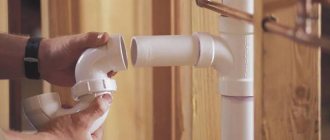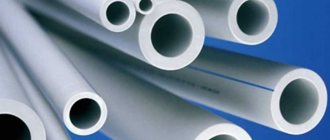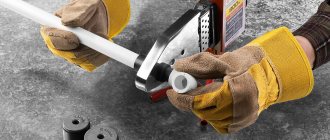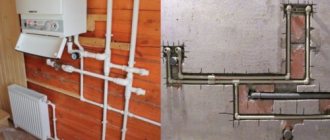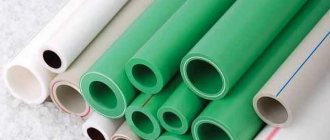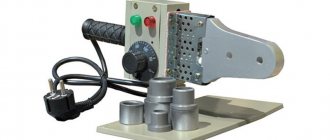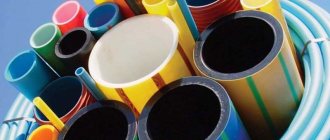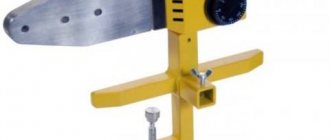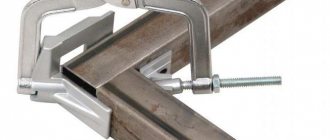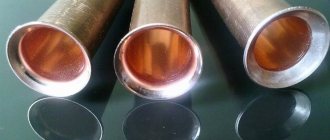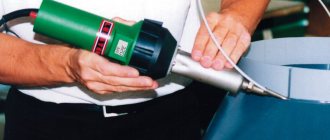The main features of plastic pipes include lower price and weight, increased service life, and ease of installation. Particularly noteworthy is the ability to connect pipes without soldering or with it, but in a faster way than metal analogues.
Let's figure out what options there are for connecting polypropylene pipes and how to apply various assembly technologies at home.
One way to connect a pipeline Source atyourserviceplumbingcompany.com
How to connect plastic pipes
There are several ways to install polymer pipes, each of which has its own characteristics. Experts recommend choosing how to connect plastic pipes depending on several conditions:
- purpose of the pipeline - water supply is often welded, sewerage is joined with sockets, heating is assembled with couplings of different types
- material of the products used - most polyvinyl chloride pipes are equipped with sockets; the industry produces compression couplings for assembling polyethylene lines; polypropylene pipes are soldered with manual or mechanical soldering irons
- scope of work - for heating pipes, installation of water supply, it is easier to buy a manual soldering iron, do the work yourself, connecting the external pipeline with sockets, for welding large diameters the services of specialized teams will be required
For polymer products, threaded connections are not used, since they cannot ensure sufficient tightness of the pipeline.
All other technologies remain available, with welding, sockets, and couplings being the most effective.
Comparison by cost
Self-installation of the presented types of pipes and fittings eliminates the cost of installation services provided by third parties and companies. At the same time, it is worth paying attention to the difference in the cost of the pipes themselves and their components. Metal-plastic pipes and fittings for them are an order of magnitude more expensive than similar products made of PVC and polypropylene for an obvious reason: the main material in them is non-ferrous metals. But to assemble metal-plastic pipelines, you do not need to buy or rent special equipment necessary for assembling polypropylene products. The difference in material costs is important for large volumes of work.
To solve different problems at one site, you can combine pipe connections from different materials; for this, manufacturers produce fittings that connect different types of products.
Connecting polymer pipes with couplings
HDPE compression couplings solve the question: “How to connect plastic pipes?” in drainage and water supply systems. They are used for standard sizes 50 – 16 mm, provide the necessary tightness and do not cause blockages.
The ends of the pipes are clamped with nuts, cone-shaped sealing rings that withstand the pressure of pressure water pipes, sewage drains, and heating circuits. There are compression couplings that are rigidly attached to the pipe body of a one-piece type.
In addition, threaded connections are used with flaring of the ends of the products after putting nuts on them. Each method is used depending on local conditions; the decision on how to connect plastic pipes is made depending on the material of the parts being joined.
In addition to compression couplings, there are similar fittings: tees, bends, plugs, flanges, saddles, taps.
Saddles and their scope
In addition to fittings, there is another interesting device that allows you to make branches from a ready-made pipeline. These saddles are specially designed couplings. This coupling has one or more threaded holes. A tap is usually installed in them, and a new branch of the water supply is connected to it.
Saddles for polyethylene water pipes
The sedeks are put on the pipe and secured with screws. After that, a hole is drilled in the pipe surface with a drill and a thick drill in the branch. When it is ready, a crane is installed and the branch is assembled further. This is how the system is improved with minimal effort and cost.
Connecting polymer pipes by welding
Polymer welding is present in 50% of household communication systems; the joints have improved characteristics, since the process occurs at the molecular level.
The user manuals included in each set of welding equipment describe in detail the technology of how to connect plastic pipes and select the heating time depending on the wall thickness.
Hand soldering irons are used for products 50 – 16 mm; large diameters are soldered with mechanical welding machines. Removable sleeves heat the ends of the pipes, after which it remains to press them with slight force for a few seconds.
Welding with electric couplings is an improved version of the previous method, since the heating and joining process is controlled by a program. The quality of the joint increases, there is no need for fixation. Devices with electrodes are used to supply voltage to the heating elements inside the coupling.
Special connection methods
Push fittings, press fittings, flanges are special compounds of polymer materials.
They also solve the problem of how to connect plastic pipes in difficult cases: a joint with a metal main, a connection of different diameters. Push fitting allows you to use a minimum of tools (calibrator, knife). The fastening element consists of polyvinyl soufflon, brass, suitable for heating and water supply circuits.
The connection is considered permanent, the tightness is ensured by rubber rings. The pipe is inserted all the way into the fitting body, after which it is impossible to remove it back. Press fittings are crimped onto the body of the pipe with a hand wrench; they are also non-removable and are suitable for heating and water supply.
Source: aquagroup.ru
Techniques for connecting plastic pipes with pipes made of other materials
When replacing outdated plumbing and heating systems, service companies are increasingly choosing plastic that is easier to install. Entire multi-storey entrances are equipped with polymer pipes.
This lightweight material, which is easy to cut, can give the impression that assembling a connection to a battery or bathtub will not pose any difficulties even for an inexperienced craftsman.
How to build a polymer riser for hot water or how to connect a plastic pipe to a metal one in a bathroom is a job the master must know thoroughly.
Characteristics of polymer pipes
Plastic pipes are a good alternative to outdated metal water pipes. Even a master inexperienced in technical aspects can easily name their advantages:
- reduced noise level from fluid movement compared to a metal counterpart;
- hermetic connection by monolithic soldering of homogeneous materials;
- resistance to environmental influences, and specifically to rust;
- smoothness of the inner surface, which does not allow sediment to accumulate.
Plastic pipes, which do not appear durable, are in fact only susceptible to strong impacts and sudden compression. Even an increase in internal pressure is less dangerous for them than for pipes made of metal or metal-plastic.
When transporting hot water, the pipe can expand, thereby reducing the risk of rupture. There are no difficulties in deciding how to connect plastic pipes to each other so that water hammer does not lead to an accident: a high-quality seam makes the joint no less durable than the walls of the pipe elbow itself.
The disadvantages of plastic communications are not so obvious, but we should not forget about them. First of all, these are the properties of expansion when heated up to a certain point, which is an advantage.
With significant heating of the environment, pipes can not only expand, but also elongate, which leads to loosening of threaded assemblies and non-monolithic connections. The critical temperature for polypropylene is considered to be +140°C, and this level is quite achievable in the event of a failure in the heating system.
The consequences of such an incident do not seem critical: the risk that the pipe will burst is practically eliminated. But the pipe can bend significantly and even destroy the masonry if placed in a hidden manner.
However, the advantages of plastic pipes are difficult to overestimate. This is the optimal material for cold water supply: by specifying how to connect the tap to a plastic pipe, you can set up a summer shower in a country house in a matter of hours, without using any specific equipment.
In addition, manufacturers of reinforced plastic pipes cope well with the problem of resistance to heat. A layer of plastic or fiberglass forms a kind of skeleton inside the pipe, preventing it from deforming under the influence of heat and pressure. You just have to take into account that when installing communications, pipes made of monolithic plastic and reinforced ones are considered different materials.
When deciding how to connect plastic pipes and plastic pipes with reinforcement, it is impossible to do without additional fittings, such as plastic fittings.
Installation of a pipeline made of plastic pipes
There is no question of how plastic pipes are connected to each other if they are the only material of the entire system. The plastic is mounted by soldering or connecting and/or distribution fittings made of the same material.
The use of metal components is not recommended: the difference in thermal conductivity will affect the quality of the connection. Methods for connecting plastic to other components depend on the material and type of reinforcement.
Building up
It is not difficult to understand how to connect plastic pipes for sewerage or water supply to extend them. The fitting for this type of material is a piece of a similar tube with a slightly larger diameter.
This capsule is placed over the cleaned and degreased edges and compressed with a special soldering iron set to medium temperature.
It’s not difficult to understand the working technique: soldering irons are designed for a certain standard diameter, so you don’t have to control the level of pressure and temperature. The connection turns out to be non-separable and even unnoticeable.
Connection with metal pipe
Connecting dissimilar pipes is more problematic. When figuring out how to connect a cast-iron sewer pipe with a plastic one or an outdated metal heating system with a modern one made of reinforced plastic, it is worth focusing on several important aspects:
- before choosing fittings, you must carefully measure the diameter of the metal elbow;
- to cut and strip a metal pipe you will need a grinder; The adapter between metal and polymer will be a plastic socket.
Having decided where and how to connect the plastic pipe to the cast iron one, you can begin installation. The operating procedure is as follows. The metal piece is cleaned and degreased. The seal is placed in the grooves of the socket and pressed tightly against the inner walls. After placing the pipes, the system is intercepted with clamps.
This technique is often used when installing a toilet. A successful alternative to such a system is a drain with a corrugated drain: since it is much easier to connect the corrugation with a plastic pipe.
Instead of fastening clamps, glue or sealant is used. Connection with a metal-plastic pipe To connect a plastic pipe with a metal-plastic pipe, collet fittings are used. Their basis is a thread applied to the outer part of the capsule. A pipe of the appropriate diameter is screwed onto it.
Collet fittings are commercially produced only for communications with a combination of materials, but also units designed for joining pipes of different diameters to each other. The use of press fittings with plastic materials is irrelevant.
You can install water supply and heating systems yourself, saving on calling a specialist. This can only be done if you are fully confident that your skills are sufficient to carry out such work.
Otherwise, the savings may be tripled to eliminate the consequences of the breakthrough.
Source: trubsovet.ru
Types of connected pipes
In order to carry out joining work efficiently without possible destruction of pipes made of various materials, it is useful to know their types and physical properties.
Metal
All metals have excellent strength characteristics, high cost, and steel and cast iron are also susceptible to corrosion. Metal pipes are made from the following alloys:
Steel. In all communications it is laid on the surface of the earth, it has the highest strength and hardness among all metals and polymers. Its galvanized varieties are often found, which have increased corrosion resistance. Steels are flexible and ductile and relatively easy to carve, but their hardness and strength make them difficult to machine.
Cast iron. A fairly popular material, large-diameter cast iron pipe products are currently manufactured; they are characterized by higher corrosion resistance than steel, but have practically zero ductility and split when deformed.
Stainless steel. It has physical characteristics similar to steel; in contrast, stainless steel has increased corrosion resistance, but due to its significant cost it is practically not found in household and utility lines.
Copper. Expensive copper pipelines have plasticity, flexibility, are connected to each other by soldering, and are often used for laying heating networks of individual houses in the area of the heating boiler.
Rice. 3 Polypropylene transition fittings
Polymer
The main advantage of polymer pipes is their inertness to most aggressive chemicals, corrosion resistance, ease of processing and low cost. In the construction and household sectors, polymer pipes made from the following plastics are used:
Low pressure polyethylene HDPE. HDPE is the main component in the manufacture of pipelines laid underground to transport water to municipal and individual homes and natural gas. It is distinguished by elasticity and flexibility; small-diameter products are connected to each other using compression fittings, electric welding (with an embedded heating element) or butt welding. Since HDPE pipes become elastic at temperatures above + 60 °C, they are used only for transporting cold water.
Polypropylene PP. The main type of material for the installation of intra-house cold and hot water mains is characterized by good strength; the pipeline is laid by soldering individual sections. The walls of PP pipes are quite thick and durable, so the pipeline does not have very good flexibility. One of the disadvantages of polypropylene is its high coefficient of thermal expansion, so for heating they use products that have an inner layer of fiberglass or aluminum foil, which gives them increased strength and reduces temperature dependence. The polypropylene connection is carried out using soldering technology, using a special soldering iron.
Polyvinyl chloride PVC. A hard and brittle material from which large-diameter sewer pipes are made, the pipeline is installed using the socket method. PVC pipes have rather thin walls, so the pipeline is laid on the surface of the earth with insignificant loads. For underground installation, multilayer PVC pipes are produced, which are lightweight and have higher performance.
Rice. 4 Adapters from polyethylene to metal - operating principle and appearance
Unplasticized polyvinyl chloride uPVC. A durable, hard and brittle material with characteristics similar to polyvinyl chloride, but more resistant to stress. External PVC-U pipes for sewerage are produced in a red color; when laid in trenches underground, they can withstand the loads of an earthen layer up to 6 m high.
Features of solderless connections
Connecting plastic pipes without soldering will not require large financial expenses. And you won’t have to get expensive soldering equipment from somewhere (obviously, not everyone has it) either.
It is worth admitting that the soldering process itself seems very complicated to some. A person must be able to properly handle a soldering machine, set the required pressure and temperature, and select solder. In general, in order to solder pipes efficiently, you really need to know a lot of nuances.
There is also an option such as soldering polypropylene pipes without a soldering iron. To do this, you simply take solder paste (this is a mixture of flux, solder powder and lubricant sold ready-made), apply it to the joint and heat it up.
Moreover, instead of a soldering iron, it is proposed to use a gas burner or lighter. But this method may also cause rejection for some, since here you have to deal with open fire.
Let's imagine a force majeure situation: there was a break in a plastic water pipe. It can take a long time to restore its seal by soldering. And restoring the tightness of pipes connected without soldering can be carried out much faster - this is a really important advantage.
Connection with fittings
To connect plastic pipes without soldering, press fittings (also known as compression fittings) or new Belgian push fittings, which are actually fixed by themselves, are very often used.
Standard press fittings are usually made from steel alloy or cast iron. And they are best used for polypropylene or other plastic pipes of small diameter.
The advantage of these plumbing products is that they can be used to build transitions between pipeline elements and connect them at different angles.
Most often, fittings are installed on bends and branches of a plastic pipeline. An ordinary press fitting consists of a main body, a cover, a sleeve and two rings: a clamping ring (it is located in a special socket) and a seam ring (it is used to fix the plastic pipe).
If we are talking about fittings with a diameter of less than fifty millimeters, then they can be installed manually, without additional devices and equipment.
And one more important rule. The plastic pipe must first be prepared before installing the fitting - cut, remove burrs, clean from dust and degrease. Such preparation must be carried out in any case, regardless of the chosen connection method.
After the plastic product is brought into an acceptable condition, you need to install a nut on it, previously removed from the fitting. Next, a clamping ring is put on this nut. Now you can insert the pipe into the fitting as far as it will go and secure it. The same actions must be done with the second pipe being connected.
Classification of fittings and adapters
Assembling pipelines using special nozzles is the most popular method of wiring engineering systems. In order to select the necessary types of fittings for polypropylene pipes, you should familiarize yourself with their detailed classification.
For the manufacture, release and supply of technical polypropylene products, the provisions of state standard No. 52134 of 2003 are used.
Types of fittings for polypropylene pipes Source ecomont.ru
Using flanges
You can connect plastic pipes with flanges without soldering. This joint is considered very reliable - metal flanges can withstand enormous positive temperatures and high pressure.
Today, even large-diameter pipelines are equipped with flanges. They provide a really strong connection.
Flanges for assembling household plastic pipelines are always threaded on one side only. As a rule, they are designed for a pressure of 1.6 MPa. At the same time, in stores you can find flange options with different sections - from 20 to 1200 mm.
The connection algorithm using flanges is quite simple. First of all, you need to carefully pull the flange onto the pipe and put on the rubber sealing gasket. The gasket should extend beyond the edge of the plastic pipe no more than one centimeter. Then the flange is carefully pushed onto this gasket.
At the next stage, joining with exactly the same flange of another plastic pipe is carried out. And the bolts here should be tightened very carefully. If you apply too much force, the plastic surface may crack.
“Hot” joining method: welding options
When using this method, 2 welding options are used:
- Soldering pipe to pipe is the most popular method.
- Fusion welding of couplings (adapters).
The first method is used when welding pipes with a diameter of more than 40 mm. The second is on pipes with a diameter from 16 to 40 mm. In this case, the fitting is needed not only to adjust the direction of pipe laying, but also as a supply of material for melting.
Various configurations of couplings (adapters) Source education-web.ru
Coupling configurations are selected based on the characteristics of the pipeline. The following types of adapters are available:
- Corners . Change of direction in any direction.
- Tees . Distribution of water supply and change of direction.
- Couplings . Docking without changing direction.
The following elements also apply:
- Bypass fittings.
- Ball valves.
- Combined products including metal-plastic.
- Threaded inside or outside pipes.
Using couplings
An ordinary coupling for plastic pipelines is a fairly simple part in its design. It consists of:
- cast iron body;
- two nuts;
- rubber gaskets;
- four metal washers.
The coupling can be found at the nearest plumbing store, or, if you have certain skills and knowledge, you can make it yourself. In this case, the characteristics of the coupling must strictly correspond to the dimensions of the products being connected.
Ordinary couplings are suitable for both pressure plastic pipelines and pipelines without pressure. With their help, they provide a reliable connection of polypropylene without the use of a soldering iron.
To form a connection, the ends of the pipes must be inserted into the coupling so that they touch in the middle. The ends must pass through washers, gaskets and nuts. Then you need to tighten the nuts tightly so that the pressure on the gaskets is strong enough.
Joining plastic pipes with a coupling provides a 100% sealed seam, even without the use of soldering. But in certain cases, for example, if the pipe is short or adjacent directly to the floor (or other horizontal surface), it is not possible to install an ordinary coupling.
For such difficult cases, a clamping coupling was invented. How to use it? First you need to clean the edge of the plastic pipe. Then you need to unscrew the coupling and put all the fastening parts on the plastic product in the correct sequence. Moreover, the sealing ring should ultimately be located at a distance of at least one centimeter from the edge of the product.
Then you need to insert the body of the clamping coupling into the end of the plastic pipe. And then you need to move all the existing rings to this body and tighten the bolt. And to the thread located on the other side of the coupling, it will be necessary to attach an “American” fitting with a plastic pipe connected to it.
To control the strength of the connection, you must carefully pull the coupling towards you, holding the pipe to which it is attached with your free hand. The coupling must remain stationary.
If it moves, it means that the wrong size part was selected. That is why it adheres so poorly to the pipeline. However, this is easy to fix - you just need to tighten the threads.
Fastening cross-linked polyethylene products
Pipes of this type can be joined independently using one of the following methods:
- using compression fittings;
- electric welded fittings;
- using press fittings.
Since the use of compression fittings requires professional equipment, this method is used quite rarely. However, it allows you to create virtually airtight connections due to the ability of cross-linked polyethylene to restore its structure after minor deformation.
If the coupling installation method is used, then you need to take a special rolling tool, a coupling for plastic water pipes and two mounting sleeves.
First, a piece of 5 mm is cut from the measured length of the pipe on one side, after which a chamfer is removed from the end. Next, a sleeve is mounted on this section, in which the pipe is flared with a manual or hydraulic tool. Then the coupling is mounted, and the second sleeve is put on top of it. The other end of the pipe is treated in the same way. For pipes made of cross-linked polyethylene, the coupling connection is quite practical, because it ensures tightness and strength.
